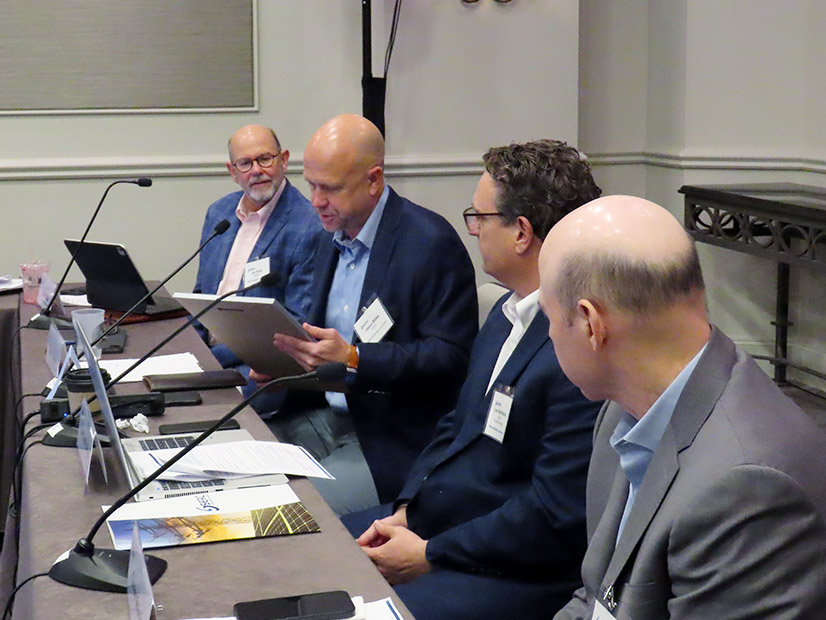PROVIDENCE — Speakers at the ISO-NE Consumer Liaison Group on March 27 discussed the system-wide costs and emissions benefits of energy efficiency and demand flexibility and called on policymakers to double down on efficiency programs as energy demand grows.
State energy efficiency programs have faced some political scrutiny in recent months amid high winter energy costs. To help reduce near-term electricity costs, the Massachusetts Department of Public Utilities in late February directed utilities to shave $500 million off the upcoming three-year plan for the Mass Save energy efficiency program.
Jamie Dickerson, senior director of climate and clean energy programs at the Acadia Center, said energy efficiency is responsible for a roughly 15% reduction in the region’s overall power demand and has brought more than $55 billion in benefits to the region since 2012.
He said it’s unfortunate energy efficiency “has emerged as a scapegoat for some,” given the cost reductions it can provide. Moving ahead, he emphasized the importance of energy efficiency as peak loads increase and estimated that achieving 20% demand flexibility in winter could save the region about $8 billion in transmission spending by 2050.
“Let’s face it: In every possible way, negawatts — with an ‘N’ — are better than megawatts with an ‘M,’” said New Hampshire Consumer Advocate Don Kreis.
However, Kreis said it can be difficult to convince ratepayers they’re benefiting from energy efficiency programs when they may not receive the actual upgrades incentivized by the programs.
David Westman of the Vermont Energy Investment Corp. (VEIC), the administrator of Vermont’s energy efficiency programs, said demand reductions — especially at peak times — provides cost and emissions benefits to the entire system.
He highlighted how Vermont has helped ski resorts improve the efficiency of their snowmaking operations and said state incentives reducing the payback period for high-efficiency snow guns are a key component to convincing resorts to adopt more efficient equipment.
At Stratton Mountain in Southern Vermont, replacing 403 snow guns has enabled a 17% reduction in seasonal kWh demand and a 40% reduction in demand during the most essential peak winter hours.
He noted that VEIC operates an energy efficiency resource participating in ISO-NE’s forward capacity market (FCM), with about 116 MW of summer capacity and 156 MW of winter capacity. The resource’s participation in the FMC has generated over $80 million in revenue since 2010, all of which is invested back into energy efficiency efforts.
Westman praised ISO-NE’s commitment to keeping energy efficiency in its capacity market as it undergoes a major market reform effort. He said PJM’s move in 2024 to make energy efficiency resources ineligible for its capacity market “puts a lot of PJM ratepayers at a significant risk of higher costs.” (See PJM Asks FERC to Eliminate Energy Efficiency from Capacity Market.)
Brett Feldman, energy efficiency manager for Rhode Island Energy, acknowledged that many of the easiest energy efficiency reductions already have been achieved, with LED lighting “basically baseline now.”
However, he said there still is a lot of home retrofit work to be done as homes electrify and said it’s important to focus on electrification whenever possible with new homes. He noted that artificial intelligence tools could help provide more gains.
The flip side of artificial intelligence is significantly increased energy demand from data centers, and several speakers expressed concern that data center demand growth may wipe out some of the gains made by energy efficiency.
“AI specialized data centers are likely to represent the single largest driver of load growth in the U.S. over the next five to 10 years,” said Tyler Norris, a Ph.D. student at Duke University who is focused on power systems.
He recently authored a study that found that, because the U.S. power system is built to meet infrequent peak loads, existing headroom on the grid “is sufficient to accommodate significant constant new loads, provided such loads can be safely scaled back during some hours of the year.”
The study found ISO-NE has the capacity to add 4.3 GW of new demand with just 1% curtailment, or 3.5 GW with just 0.5% curtailment.

